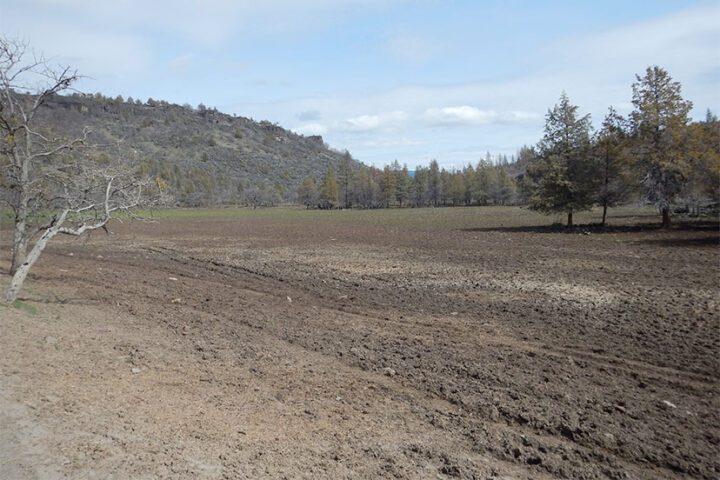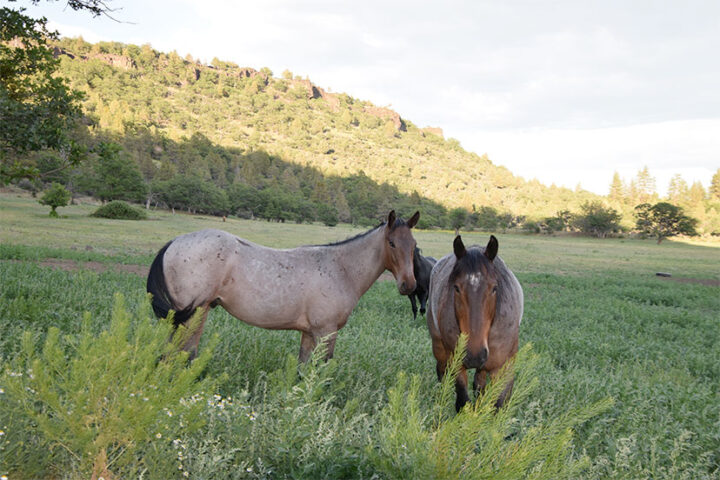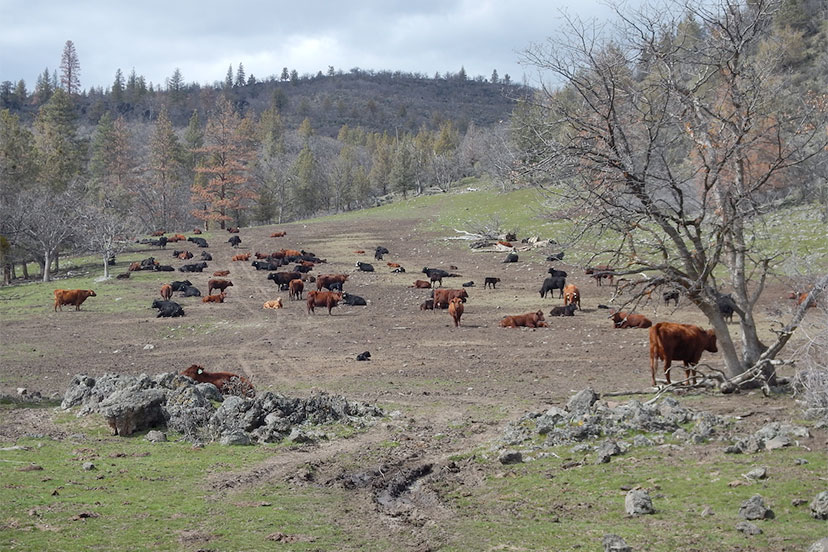“There’s a right way and a wrong way to graze cattle. This devastated area in Northern California is the perfect example of the wrong way!”
— Deb Ferns, President of Wild Horse Fire Brigade, April 2, 2023
Shown above, a herd of cattle that have devastated the landscape east of Fall Creek on the south side of Copco Road in California. Their unmanaged grazing interrupted natural reseeding of flora, leading to defoliation of a meadow’s cover crop.
The image below was taken March 31, 2023 of a wilderness alpine meadow that had been devastated by cattle… which digest virtually all plant seeds consumed.

Wild horses digest their food differently than ruminant livestock (cattle, sheep and goats) and that has a serious impact on our pristine wilderness areas.
This same alpine meadow was photographed (below) in early May 2021, and had been used by wild horses for centuries without harm.
Wild horses naturally reseed native flora because they pass virtually all the seeds they consumer in their dung. This is a function of their simple stomach… and is a characteristic that helps maintain native cover crops.

During the course of giving a national newspaper reporter an interview and tour, a grievous sight was discovered.
A formerly pristine alpine meadow in a wilderness area had been devastated by a local livestock producer and their cattle. And the physical evidence was beyond any reasonable doubt. From the evidence on the ground and from photos of the area over the past two-years, it’s clear that the livestock managers from a ranch near Fall Creek in Oregon have wintered their herd of cattle in this area in Siskiyou County California.
I made an impromptu video using an iPhone to document some of the shocking damage caused by the cattle.
The video also documents littering (plastic hay bale strings, etc.) on the landscape, with plastic becoming part of the soils on the landscape being used by the livestock producers. The area involved is about two miles east of Fall Creek, on Copco Road in Hornbook, California. I believe these impacts were caused by livestock and managers operating from a ranch in Jackson County, Oregon.
Having seen the photos of the area and the videos, Deb Ferns, the President of Wild Horse Fire Brigade said; “There’s a right way and a wrong way to graze cattle. This devastated area in Northern California is the perfect example of the wrong way!”
In the photo image of the herd of cattle, (top of page) a greenish area is seen on the ground in the center of the herd. This green area is the fine remains of hay bales that were spread out over a large area to feed the cattle, since they had already stripped-off most of the native plants and grasses in the immediate area.
The issue with feeding hay in wilderness areas is that hay is grown and baled down in the lower valleys where invasive species weeds are a serious problem. And these invasive weeds and their seeds are imported into wilderness areas in hay bales. This is another serious management issue that is integral to livestock being ranged in wilderness areas, especially ‘critical wilderness’ areas that must be protected from importation of invasive species weeds by livestock managers.
The article titled ‘Blaming Wild Horses For the Spread of Invasive Species Weeds is a Twisted Tale’ discusses the importation of invasive species weeds into wilderness by livestock managers feeding hundreds of cattle daily requiring dozens of bales of contaminated hay daily.
That article can be read here.
The Good News:
Michelle Gough and myself, who are part of the all-volunteer California 501-c-3 nonprofit team at ‘Wild Horse Fire Brigade’, are wild horse researchers who live among and study free roaming native species American wild horses in this remote wilderness area on the California-Oregon border. Our research is turning-up cost-effective solutions and proven plan called ‘Wild Horse Fire Brigade’ that benefits multiple private and public land-use stakeholders.
Benefits of the plan called ‘Wild Horse Fire Brigade’:
1. Plan creates more ecologically sensible grazing for livestock producers; and
2. Plan enhances western cervid (deer, elk, etc.) habitat; and,
3. Plan creates more wildfire resilient forests, benefiting wildlife, hikers, timber industry and fisheries; and
4. Plan reduces the frequency, size and intensity of catastrophic wildfires, and reduces toxic wildfire smoke (greenhouse gas), and
5. Plan benefits native species American wild horses by relocating them away from areas where they are deemed as being in conflict with commercial enterprises and relocates them into remote critical wilderness areas that are both ecologically and economically appropriate.
6. Plan keeps carbon compounds sequestered in soils by reducing the need for polluting prescribed burns, which volatilize sequestered carbon, and;
7. Plan saves homes from wildfires and reduces casualty and capital losses.
The research and resulting new information that is coming from the efforts of Wild Horse Fire Brigade will empower both advocates and range managers, allowing for greatly improved wild horse and range management, which is proven to benefit wilderness ecosystems in ways that are now just being revealed by this research effort.
The research station where we are stationed is called ‘Wild Horse Ranch’. Wild Horse Ranch serves as the pilot study area in regard to how wild horses reduce wildfire by naturally managing wildfire fuels in a manner that is symbiotic to a myriad of flora and fauna.
More about how the ‘Wild Horse Fire Brigade’ plan works can be downloaded here.
We also collect information about the behavioral ecology and ethology of wild horses using a study method that we’ve coined as the ‘Goodall Method’ in honor of Dr. Jane Goodall who pioneered wildlife study as an embedded observer with the apes she studied during her 1960 work in Gombe Africa.
Together, we have captured over a quarter-million photographs, and dozens of hours of videos of wild horses in their local wilderness study area, which augment their ongoing intimate close-range observational studies of wild horses.
More about livestock grazing is available from Stacilee Sherwood, here.
William E. Simpson II is a naturalist, author, and conservationist living in the Soda Mountain wilderness area among the wild horses that he studies. Learn more at Wild Horse Fire Brigade.

